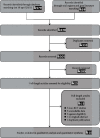Extracorporeal Shockwave Therapy for Treating Chronic Low Back Pain: A Systematic Review and Meta-analysis of Randomized Controlled Trials
- PMID: 34840977
- PMCID: PMC8617566
- DOI: 10.1155/2021/5937250
Extracorporeal Shockwave Therapy for Treating Chronic Low Back Pain: A Systematic Review and Meta-analysis of Randomized Controlled Trials
Abstract
Objective: To assess the effectiveness and safety of extracorporeal shockwave therapy (ESWT) for the treatment of chronic low back pain (CLBP).
Methods: This was a systematic review and meta-analysis of randomized controlled trials (RCTs) designed in accordance with the Preferred Reporting Items for Systematic Reviews and Meta-analysis statement standard. We identified relevant studies by searching multiple electronic databases, trial registries, and websites up to April 30, 2021, and examining reference lists. We selected RCTs that compared ESWT, in unimodal or multimodal therapeutic approaches, with sham ESWT or other active therapies. Two investigators independently extracted data and assessed the risk of bias and quality of the evidence. The main outcomes were pain intensity and disability status, examined as standardized mean differences (SMD) with 95% confidence intervals (CI). The risk of bias was assessed by using Cochrane Back and Neck (CBN) Group risk of bias tool and Jadad score, and GRADE was applied to determine the confidence in effect estimates. Heterogeneity was explored using sensitivity analysis and meta-regression.
Results: Ten RCTs, including a total of 455 young to middle-aged individuals (29.2-55.8 years), were identified. Compared with control, the ESWT group showed lower pain intensity at month 1 (SMD = -0.81, 95% CI -1.21 to -0.42), as well as lower disability score at month 1 (SMD = -1.45, 95% CI -2.68 to -0.22) and at month 3 (SMD = -0.69, 95% CI -1.08 to -0.31). No serious shockwave-related adverse events were reported.
Conclusion: The use of ESWT in CLBP patients results in significant and quantifiable reductions in pain and disability in the short term. However, further well-conducted RCTs are necessary for building high-quality evidence and promoting the application of ESWT in clinical practice.
Copyright © 2021 Lei Yue et al.
Conflict of interest statement
The authors declare that they have no competing interests.
Figures




Similar articles
-
Efficacy and safety of extracorporeal shockwave therapy in chronic low back pain: a systematic review and meta-analysis of 632 patients.J Orthop Surg Res. 2023 Jun 24;18(1):455. doi: 10.1186/s13018-023-03943-x. J Orthop Surg Res. 2023. PMID: 37355623 Free PMC article.
-
Comparison of Different Treatment Regimens of Extracorporeal Shockwave Therapy in Chronic Low-back Pain: A Randomized Controlled Trial.Pain Physician. 2022 Nov;25(8):E1211-E1218. Pain Physician. 2022. PMID: 36375191 Clinical Trial.
-
Therapeutic ultrasound for chronic low back pain.Cochrane Database Syst Rev. 2020 Jul 5;7(7):CD009169. doi: 10.1002/14651858.CD009169.pub3. Cochrane Database Syst Rev. 2020. PMID: 32623724 Free PMC article.
-
Psychological therapies for the management of chronic pain (excluding headache) in adults.Cochrane Database Syst Rev. 2020 Aug 12;8(8):CD007407. doi: 10.1002/14651858.CD007407.pub4. Cochrane Database Syst Rev. 2020. PMID: 32794606 Free PMC article.
-
Extracorporeal Shockwave Therapy for Greater Trochanteric Pain Syndrome: A Systematic Review with Meta-Analysis of Randomized Clinical Trials.JBJS Rev. 2024 Aug 20;12(8). doi: 10.2106/JBJS.RVW.24.00091. eCollection 2024 Aug 1. JBJS Rev. 2024. PMID: 39297780
Cited by
-
Efficacy and safety of extracorporeal shockwave therapy in chronic low back pain: a systematic review and meta-analysis of 632 patients.J Orthop Surg Res. 2023 Jun 24;18(1):455. doi: 10.1186/s13018-023-03943-x. J Orthop Surg Res. 2023. PMID: 37355623 Free PMC article.
-
The Use and Benefits of Focused Shockwaves for the Diagnosis of Myofascial Pain Syndrome by Examining Myofascial Trigger Points in Low Back Pain.Biomedicines. 2024 Dec 20;12(12):2909. doi: 10.3390/biomedicines12122909. Biomedicines. 2024. PMID: 39767813 Free PMC article.
-
Observation of curative effect on meridian theory-based extracorporeal shock wave therapy for non-specific low back pain: study protocol for a randomized controlled trial.J Orthop Surg Res. 2022 May 13;17(1):265. doi: 10.1186/s13018-022-03146-w. J Orthop Surg Res. 2022. PMID: 35562830 Free PMC article.
-
Advancements in Therapeutic Approaches for Degenerative Tendinopathy: Evaluating Efficacy and Challenges.Int J Mol Sci. 2024 Nov 4;25(21):11846. doi: 10.3390/ijms252111846. Int J Mol Sci. 2024. PMID: 39519397 Free PMC article. Review.
-
Extracorporeal shock wave therapy for low back pain: A systematic review and meta-analysis.Medicine (Baltimore). 2023 Dec 29;102(52):e36596. doi: 10.1097/MD.0000000000036596. Medicine (Baltimore). 2023. PMID: 38206739 Free PMC article.
References
Publication types
MeSH terms
LinkOut - more resources
Full Text Sources
Miscellaneous

